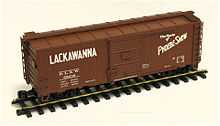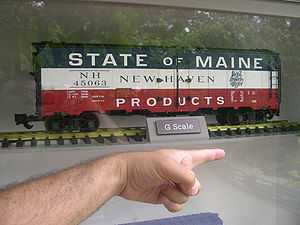G scale
| G scale | |
|---|---|
|
G scale train model | |
| Scale ratio | 1:22.5 |
| Standard(s) | originally LGB |
| Model gauge | 45 mm (1.772 in) |
| Prototype gauge | 1,000 mm (3 ft 3 3⁄8 in) metre gauge |


G scale (or G gauge) is a scale for model railways which, because of its size and durability, is often used outdoors. Such installations are known as garden railways.
LGB
G scale was introduced by Ernst Paul Lehmann Patentwerk under the brand name LGB and was intended for indoor and outdoor use. Lehman Patentwerk, founded in 1881, started producing LGB in 1968. The remains of the company were bought by Märklin and production of certain items continues.
The G name comes from the German word groß meaning "big". More recently some people have come to interpret it as standing for garden scale.
'G Scale' versus 'G Gauge'
A railroad gauge is the distance between the railheads. Standard US trains, for example, run on rails spaced 4 ft 8 1⁄2 in (1,435 mm) standard gauge apart whereas some narrow-gauge trains (serving mines, etc.) run on rails only 3 ft (914 mm) apart. Although built with standard-sized doors, a narrow-gauge train is in some other respects smaller than its standard-gauge cousin: its cars are generally narrower and shorter, allowing them to navigate often more sharply cornered tracks.
Model trains are built to represent either a real train of standard or narrow gauge. In an HO model, for example, HO track is used to represent real standard gauge and some narrower-gauge track such as N is used to represent real narrow gauge.
G model-railways depart from this and always use the same gauge. Trains are instead built in different sizes depending on whether they are intended to represent standard-gauge or narrow-gauge trains. Because of this it might be more correct to speak of "G Gauge," the consistent aspect being the gauge, 45 mm (1.772 in), and not the scale.
G scale is thus the use of 45 mm (1.772 in) gauge track to represent both real standard gauge trains and real narrow-gauge trains, originally those of the European 1000mm gauge, at 1:22.5. Other narrow-gauge trains are modelled at other scales.
The origins of the gauge was called '1 Gauge' or 'Gauge One' which was first used in Europe and England being 1.75 in (44.45 mm). Used to model standard gauge trains in the scale of 1:32. LGB were first to adopt the term 'G Scale' and used the gauge of 45mm to model 1,000mm gauge European trains in 1:22.5 scale. Many modelers are of the notion that the term 'Large Scale' is best to describe the various scales of models that usually run on 45 mm (1.772 in) track.
Below are some typical scales with more specific terms that all run on 45 mm gauge track:
Gauge One scaled at 1:32 used to model standard gauge trains of 4 ft 8 1⁄2 in (1,435 mm) standard gauge gauge.
'G' scale 1:22.5 used to model European trains that run on 1,000 mm (3 ft 3 3⁄8 in) gauge track.
'H' scale (1/2" to the foot) 1:24 used to model 3 ft 6 in (1,067 mm) narrow gauge or 'Cape gauge'. Incorrectly used for 3 ft (914 mm) narrow gauge track.
'F' or 'Fine scale' 1:20.32 typically used to model North American narrow gauge trains on 3 ft (914 mm) gauge track.
SE (7/8" to the foot) 1:13.7 used to model trains on 2 ft (610 mm) narrow gauge track.
Manufacturers in the U.S. and Canada and their scale products
- Wrightway Rolling Stock 1:32 and 10mm scale custom built British North American and European passenger stock. [Ontario, Canada]
- Northern Fine Scale Stock in 10mm scale British only freight stock in kit form
- Accucraft has five scales - Fn3 is 1:20.3, Gauge 1 is 1:32, their ½" scale is 1:24. They also build 1:29 scale North American models in live steam and electric under the AML brand, as well as British live steam and electric models in 1:19th scale [also called 16mm] and Isle of Man live steam and electric models in 1:20.3 scale - the Isle of Man uses three foot gauge track, the same width as the dominant US Colorado narrow gauge.
- Aristo-Craft is 1:29, “Classic” series is 1:24 (Aristo-craft is out of business.)
- Aster is 1:32, 1:30 for Japanese prototypes and 1:22.5 for European and Japanese narrow gauge.
- Bachmann's "Big Haulers" series is to 1:22.5, while their "Spectrum" Series is to 1:20.3 scale
- Hartland Locomotive Works products are engineered to fit with 1:24 scale Narrow Gauge equipment and 1:29 Standard Gauge equipment.
- LGB is 1:22.5
- Mainline America is 1:32
- Märklin "MAXI" is 1:32
- MTH Rail-King is 1:32
- Piko is 1:22,5
- USA Trains “Ultimate” Series is 1:29, “American” Series is 1:24
LGB and numerous other manufacturers [Train-Li, PIKO, Peco] produce track made of brass which can remain outside in all weathers – a quick wipe and it is ready for use. Track can also be obtained in less expensive aluminium as well as oxidation-resistant, though more expensive, stainless steel.
See also
- Gn15 - G Scale models of 15 in (381 mm) gauge trains on 16.5 mm (0.65 in) gauge track
- Rail transport modelling scales
- Model railway scales
- SE scale
- Gauge 1
- Garden railway
External links
- G Scale at DCCWiki - Further information for G scales with links to DCC topics.
- G Scale Central Network
- G-Scale Society
- Garden Trains
- Garden Railways magazine
- History of G gauge & other gauges (N, Z, OO, etc.)
- myLargescale.com G Scale online community
- G Scale News
- The World of LGB
